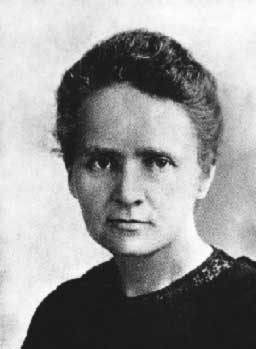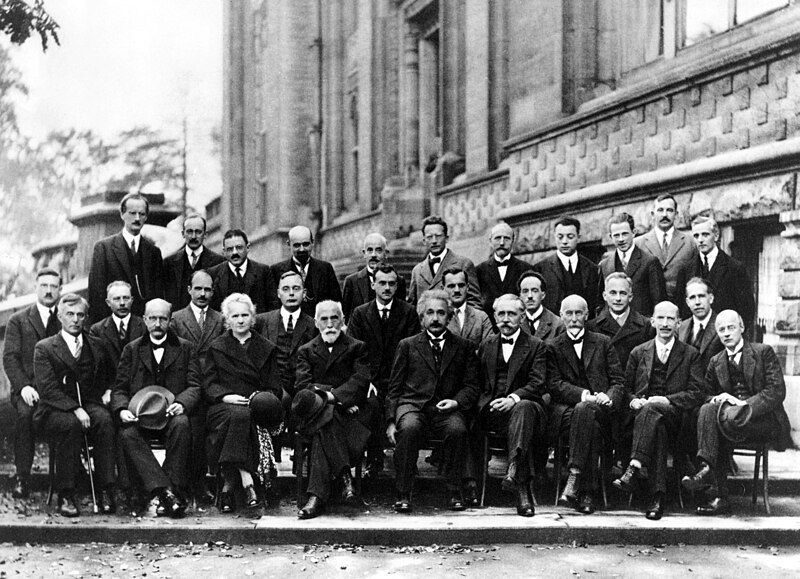Marie Curie
By: Siddhant Kansal

Marie Curie (b. 7 November, 1867 – d. 4 July, 1934) is the co-founder of radioactivity and most commonly known as the “mother of chemistry” for her astounding discoveries which were considered unfeasible to accomplish especially by a woman at the time. Marie Curie is the most important figurehead in scientific history and her work and research laid down the foundations for modern science till this very day.
Biography
Marie Curie’s Maiden name was Maria Salomea Sklodowski. She was born on November 7, 1867 in Warsaw, the capital of Poland. She had four older siblings, three sisters and one brother. Curie’s family was always financially troubled. At the time, Poland was occupied by Russia and many polish workers, including Curie’s father, lost their jobs to Russians. Curie’s parents wanted both her and her siblings to be very well educated. She was the smartest and brightest student in her class. Marie Curie graduated from high school at the young age of 15 years.
Curie was greatly interested in scientific research, and had a strong motivation to continue studying and get a degree in college. However, a very scarce number of universities in the world accepted women in their institution at that time period, let alone women not being allowed to attend college altogether in Poland. She was left with no other alternative and decided to follow her older sister, Bronia, and move to Paris to find a university and get an official college degree.
Due to scarcity of money from the family, at age 17, Curie started working as a governess to help pay for her trip to Paris and help pay for her college. She registered at Sorbonne in Paris under the name of Marie Curie to make people believe she was French. She lived in a shoddy run-down apartment close to her school and survived on only bread and tea throughout her entire college years. Despite her starvation and suffering health, she earned her master’s degree in July of 1893 and graduated in the top of her entire class. Highly impressed with her intellect, and far surpassing every male classmate in her college, she earned a scholarship to earn a second degree in mathematics, which she got in 1894.
Curie was given a research grant to study chemistry. While trying to find a lab space, she met Pierre Curie, who was a brilliant researcher He gave her a small lab space where he worked. The two were then shortly after married in 1895. They had a daughter two years later who they named Irene in 1897 and another daughter named Eve in 1904. However both daughters were raised by Pierre’s father since both Marie Curie and her husband had no spare time with the work they were doing.
Intrigued by Henri Becquerel’s uranium experiments about strange rays emitted from this element, Marie Curie and her husband started to do countless days on research on this vague topic. While researching, she encountered an ore that emitted much more radiation than uranium, this led to her significant discovery of two new elements, Radium and Polonium. In November of 1903, before the birth of their second daughter, Marie Curie and her husband received a Nobel Prize in physics for their contribution to the understanding of the atomic structure. Later in 1911, after her husband’s death, Marie Curie received another Nobel Prize in chemistry for the discovery of polonium and radium.
In April of 1906 Marie Curie’s Husband was killed in a horse carriage accident. Marie Curie stopped her research in 1914 when World War I began. She created portable X-Rays in ambulances for doctors to use on the sidelines of the battlefield. With the help of her daughter, Irene, Marie Curie would take over one million x-rays and train 100 women to use x-rays to treat wounded soldiers. This made Curie gain a lot of respect from the French people and she was starting to be viewed as a French patriot, despite being of Polish origin. In 1934 Marie Curie died as she lived, discovering the mysteries of radiation, as it was radiation poisoning that ended up taking her life. She is buried in the Pantheon in Paris, which is where France buries all of its heroes.
Contributions to STEM

The main reason Marie Curie’s name is in the history books is because of her discovery of two elements, Radium and Polonium. Along with this discovery, she also created portable x-rays for use in ambulances and hospitals. Her discoveries and advances in radioactivity made huge advances in the scientific community and gave her international fame. However, one important factor also helped contribute to her fame and made every achievement she completed even more impressive to everyone; she was a female. In a male dominated science society, she was the first female to get a doctorate in physics, first female to get a Nobel Prize in a STEM category, and first human being to get two Nobel Prizes. She became an inspiration and role model to every woman in the world at that time period as her achievements were heard everywhere and her research provided a huge jump start to the scientific community. Her work caused the men in their science labs to ponder if it was a mistake to not educate women as well as men and caused the women to have new hope knowing that they are much more capable than what was expected of them.
Interesting Facts
- Marie Curie attended a secret school in Poland called “the flying university” which was intended only for women in Poland because no colleges would accept women in Poland. This university had no campus or any official enrolment, it only consisted of a small group of women who would hold covert meetings in people’s homes and teach women who had a passion for learning.
- Her mother died of TB when she was only nine years old, for the children to cope with this heavy loss, they would pretend they were miracle scientists, not knowing one day this would become a reality for Marie.
- Marie changed her name from Maria to Marie so she could sound more French and have a higher chance of being accepted in a college in France, this name would stick with her for the rest of her life.
- Marie’s interest in physics started from her cousin Jozef Boguski, who was the director at the Warsaw Museum on Industry. He allowed her to do experiments in physics and chemistry over the weekends in the museum, this started her interest in physics which eventually would lead to her decision in which scientific field to pursue as a college degree.
- Originally, Marie Curie wanted to become a teacher, like her mother. That changed, however, when she met Pierre Curie who encouraged her to pursue the field of scientific discovery.
- Curie named Radium after the Latin word radius, which means “rays”. And Polonium was named after Curie’s home country, Poland.
- Marie Curie is credited for coining the term “Radioactive”
- In June of 1903, Marie Curie became the first woman in Europe to receive a doctorate in Physics.
- The Nobel Prize nominations committee objected to having a woman being nominated for a Nobel Prize, however, Pierre fought for his wife and insisted that all of the original research belonged to his wife and she also deserves credit for the discovery, if not all of the research.
- Marie curie was about to have a third daughter but suffered a miscarriage, Most likely due to exposure of high amounts of radiation
- Marie never wanted to acknowledge the dangers of radiation. She only saw its potential to heal people. She kept a small vial of highly irradiated radium salts by her bedside because she was fascinated by the faint blue light it emitted in the darkness.
- In addition to the Nobel Committee refusing to give membership for Marie to attend her own Nobel Prize ceremonies, angry mobs gathered outside her home and threw rocks at her house. Despite this she still attended the ceremony and developed a bitter hatred to the male science establishment.
- Marie mainly hired female scientist who were also discriminated by the male dominant science society. One of these people she hired was Marguerite Perey, who was originally a test tube washer and later would end up discovering her own element called Francium, named after France.
- Marie’s daughter, Irene, would follow in her mother’s footsteps and end up winning her own Nobel Prize in 1935 in chemistry and Eve, her second daughter, became a successful author.
- Curies received another honor in 1944 with the discovery of the 96th element called Curium which is honorably named after the Curies for their significant contributions to chemistry.
- Some on Marie’s research notes are still too radioactive to handle even today. Marie was the only female member of the Conseil du Physique Solvay, a league that consists of some of the most famous scientists in history, including very well-known people such as Albert Einstein and Ernest Rutherford.
Impact on 21st Century Society and Culture
Today, radium is used as a method of cancer treatment. Radium, when chemically combined with chlorine, produces radon gas which can help treat bone cancer. Polonium acts as a lightweight, nuclear heat source, as it had the tendency to spontaneously heat up to 500 degrees Celsius. Although these elemental discoveries is why Marie Curie became famous, this is not the only impact she has left on this century. Her research and contribution to nuclear science and chemistry as the co-discoverer of radioactivity and her name as an inspiration and a role model to women in STEM fields everywhere is a big impact she has left on today’s culture. She laid the foundation for nuclear science which eventually led to nuclear energy which is the most efficient and cleanest form of energy today. She also holds quite some weight to her name as being the most famous and well known female scientist in the world and often times is an inspiration to all newcomer female scientists who wish to make a name in the male dominated scientific community.
Works Cited
"Are You Curious about MADAME CURIE?" A Biography of Marie Curie for KIDS!. Web. 04 Feb. 2014.
Bagley, Mary. "Marie Curie: Facts & Biography." LiveScience. TechMedia Network, 14 Aug. 2013. Web. 02 Feb. 2014.
Bellis, Mary. "Madame Curie - Marie Curie and Radioactive Elements." About.com Inventors. About.com, 20 Dec. 2013. Web. 02 Feb. 2014.
"Facts About Polonium." LiveScience. TechMedia Network, 05 Sept. 2013. Web. 04 Feb. 2014.
"Facts About Radium." LiveScience. TechMedia Network, 12 Sept. 2013. Web. 04 Feb. 2014.
"Marie Curie - Biographical". Nobelprize.org. Nobel Media AB, 2013. Web. 4 Feb 2014.
Comments (0)
You don't have permission to comment on this page.